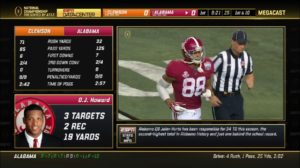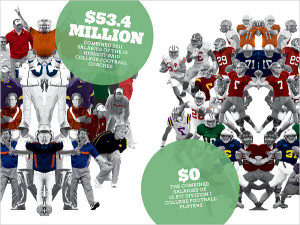As it happens, nothing explains the magnitude of this upset quite like this pre-game headline in The New York Times:
Alabama’s Toughest Competition Might Be Its Second String. Or Its Third.
Well, a funny thing happened on the way to Alabama’s title:
Using big plays, capitalizing on Alabama turnovers and riding the poise of [19-year-old Freshman quarterback Trevor Lawrence], Clemson beat Alabama, 44-16, in the College Football Playoff [CFP] championship game at Levi’s Stadium.
It was the fourth year in a row that Alabama and Clemson had met in college football’s four-team playoff, and the third time they faced off in the championship game. Clemson (15-0) has now won two of those three games, adding to the national title it won at the end of the 2016 season.
(The New York Times, January 7, 2019)
Frankly, Alabama looked like it was playing its third string the entire game. But I shall leave all the post-game analyses to commentators who care.
It is noteworthy, though, that the Tigers vs. Crimson Tide is beginning to create the lore of storied rivalries like the Packers vs. Bears, the Lakers vs. Celtics, and the Yankees vs. Red Sox. Indeed, it’s a measure of the national interest this game generated that ESPN carried it on all four of its cable channels. Never mind that watching it on three of them was like watching a business channel.
 For some stupefying reason, those three channels limited coverage of play on the field to just one of several windows on the screen. Meaning play was competing for eyeballs with the other windows, which were filled with meaningless game stats, player stats, and random sports news or tweets, respectively.
For some stupefying reason, those three channels limited coverage of play on the field to just one of several windows on the screen. Meaning play was competing for eyeballs with the other windows, which were filled with meaningless game stats, player stats, and random sports news or tweets, respectively.
What’s the point of having a 40-inch TV if you can watch the game only on a small part of the friggin’ screen?! But I digress …
As indicated above, I am not a fan of college football. Perhaps this is because I did not attend one of far too many colleges in America whose reputation is based more on athletics than academics. Whatever the case, I’ve never had any bragging interest in the outcome of any NCAA championship (in any sport).
The only reason I watch this annual spectacle is to establish standing to vent my abiding lament about college football masquerading as an amateur sport. This excerpt from “Reggie Bush Forfeits Heisman Trophy,” September 16, 2010, crystallizes my concerns:
___________________
There’s nothing amateur about college football. It’s a multibillion-dollar business for Christ’s sake!
 More to the point, the people generating its revenues are not the university presidents, athletic directors, or coaches who, incidentally, make millions of dollars in salary and endorsement deals. Instead, they are the poor, mostly black athletes whose raw talent colleges exploit to pack 100,000 fans into their stadiums on game day.
More to the point, the people generating its revenues are not the university presidents, athletic directors, or coaches who, incidentally, make millions of dollars in salary and endorsement deals. Instead, they are the poor, mostly black athletes whose raw talent colleges exploit to pack 100,000 fans into their stadiums on game day.
I have always felt that it’s tantamount to modern-day slavery for universities to recruit poor and, all too often, uneducated athletes just to play Football and not compensate them for their services, especially considering they rarely get an education. …
But this indentured servitude is made much worse by branding these poor players – who generate tens of millions for their respective universities – as cheaters for accepting a little cash on the side. Mind you, those offering the cash are often boosters just trying to make life easier for players to enable them to perform better. Not to mention that, if the NCAA were to penalize all college players who accept such gifts, there would be no college football (or basketball) worth watching.
The hypocrisy inherent in this is beyond shameful. Universities should be required to compensate student athletes in direct proportion to the way owners of professional football teams compensate their players.
_________________
That said, the only redeeming feature in this respect is that most major NCAA teams are now featuring blacks as quarterbacks. They were the exception not so long ago. They are fast becoming the rule. For example, two of the four starting quarterbacks for this year’s CFP were black; three of the four were last year.
More importantly, this and other high-profile positions greatly increase the likelihood of players making the first round of the NFL draft. This in turn guarantees multimillion-dollar contracts, which provide belated compensation for their indentured servitude.
For the NFL, players must be three years removed from high school. To play in the NBA, they are required to wait a year after high school. In Major League Baseball, players can be drafted out of high school, but if they go on to attend a four-year college, they must be there for at least three years.
(Tulsa World Sports Extra, April 20, 2013)
Remarkably, all legal challenges to this obvious case of collusion between college Football and the NFL have failed. And inherent in this is sanctioned discrimination against college football players.
Which means that, despite being able to make millions in the NFL, Clemson’s freshman sensation will have to play for free for two more years before he can enter the draft.
In any event, I shall end with this bit of advice for all eligible players (in every sport): Strike while the iron is hot. Declare emancipation and enter the draft!
Congratulations, Tigers!
Related commentaries:
Reggie Bush…
Student-athletes graduate poor … and dumb

